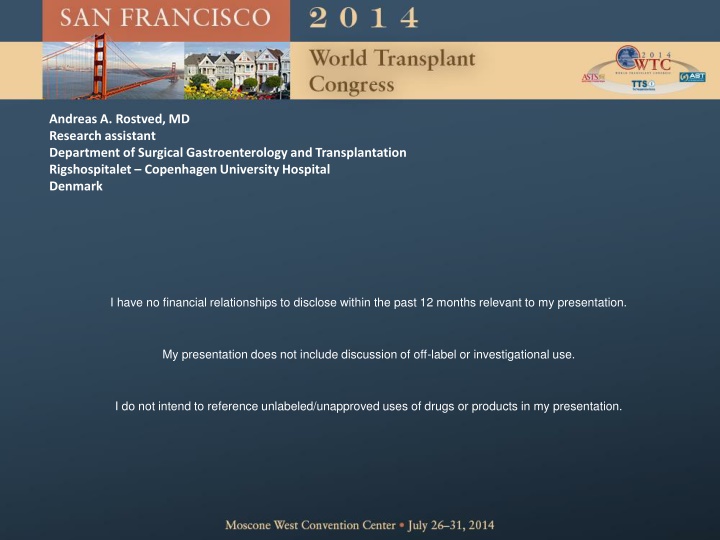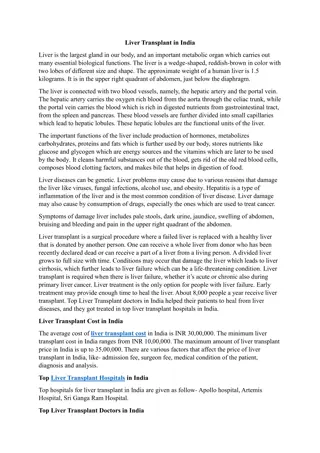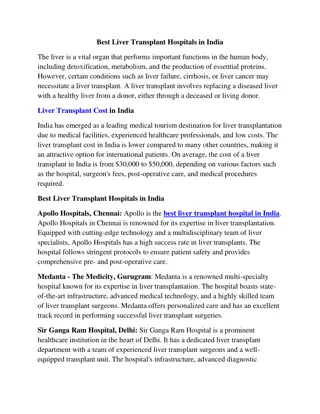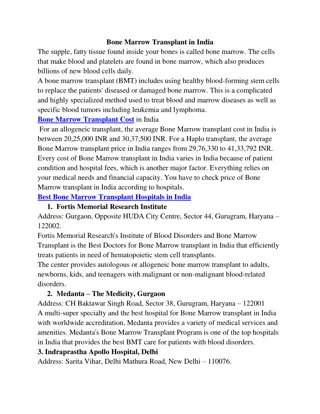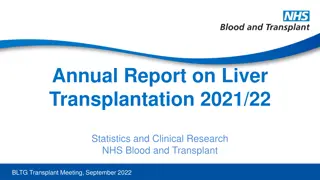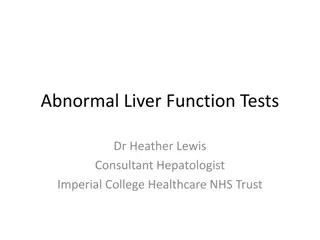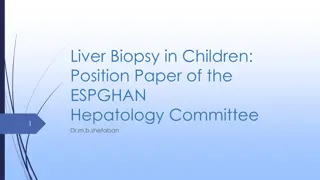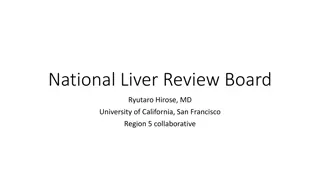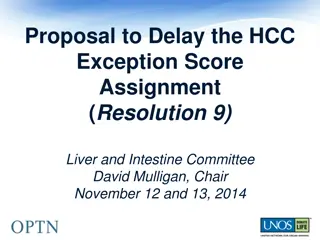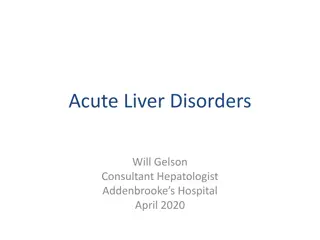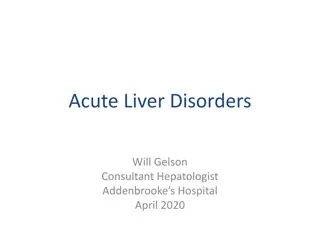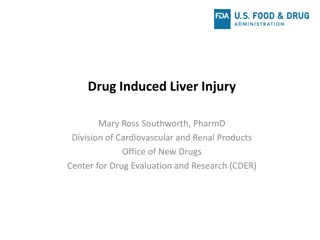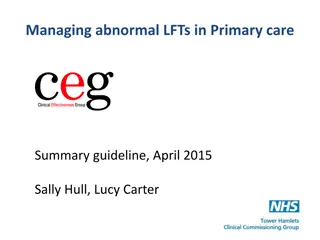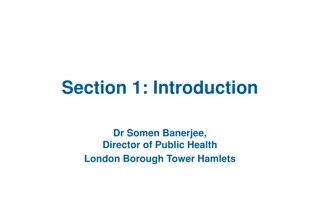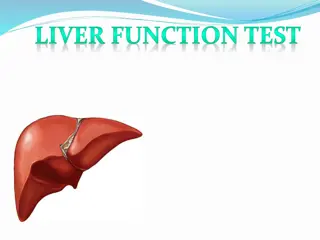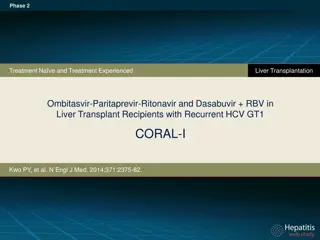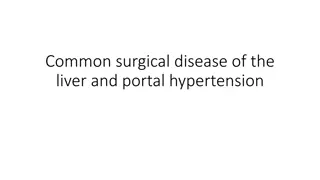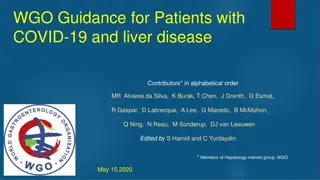Early Prognostic Factors for Liver Transplant Recipients
Within the first year post-liver transplantation (LTx), predicting mortality and re-transplantation is crucial. This study evaluates the MELD score as an early prognostic factor using a retrospective observational approach on adult liver transplant recipients. The objective is to determine its predictive ability for 1-year mortality or re-transplantation.
Download Presentation

Please find below an Image/Link to download the presentation.
The content on the website is provided AS IS for your information and personal use only. It may not be sold, licensed, or shared on other websites without obtaining consent from the author.If you encounter any issues during the download, it is possible that the publisher has removed the file from their server.
You are allowed to download the files provided on this website for personal or commercial use, subject to the condition that they are used lawfully. All files are the property of their respective owners.
The content on the website is provided AS IS for your information and personal use only. It may not be sold, licensed, or shared on other websites without obtaining consent from the author.
E N D
Presentation Transcript
Andreas A. Rostved, MD Research assistant Department of Surgical Gastroenterology and Transplantation Rigshospitalet Copenhagen University Hospital Denmark I have no financial relationships to disclose within the past 12 months relevant to my presentation. My presentation does not include discussion of off-label or investigational use. I do not intend to reference unlabeled/unapproved uses of drugs or products in my presentation.
Post-Transplant MELD Score Predicts Mortality and Re- Transplantation Among Liver Transplant Recipients Andreas A. Rostved, Allan Rasmussen - Department of Surgical Gastroenterology and Transplantation, Rigshospitalet Copenhagen University Hospital, Denmark Lars Peters, Caspar Da Cunha-Bang, Jens D. Lundgren CHIP, Department of Infectious Diseases and Rheumatology, Rigshospitalet Copenhagen University Hospital, Denmark
Introduction Within the first year after liver transplantation (LTx) 10-15 % die or are re-transplanted [1]. Early warning indicators after transplantation of poor outcome is lacking but would facilitate more rational risk stratification management and could further assist in understanding the processes around the transplantation leading to poor outcome. The Model of End-stage Liver Disease (MELD) score is used to prioritize patients on waiting list and preliminary data also suggest that post-LTx MELD scoring is associated with short- term 3-month mortality [2, 3]. Further validation of the independent predictive ability of MELD scores in the first few weeks after LTx on long-term outcome has yet to be established. 1. Kim, W.R., et al., OPTN/SRTR 2012 Annual Data Report: liver. Am J Transplant, 2014. 14 Suppl 1: p. 69-96. 2. Wagener, G., et al., Predicting early allograft failure and mortality after liver transplantation: the role of the postoperative model for end-stage liver disease score. Liver Transpl, 2013. 19(5): p. 534-42. 3. Wong, C.S., et al., Scoring short-term mortality after liver transplantation. Liver Transpl, 2010. 16(2): p. 138-46.
Objective Our aim was to evaluate early continuous post-LTx measurements of the MELD score as an early independent prognostic factor for 1-year mortality or re-transplantation.
Methods Single center retrospective observational study All adult liver transplant recipients from DBD were included from January 2007 to October 2013. MELD was determined prior to, and daily from day 1-35 post-LTx. Kaplan Meier analysis was used to estimate the proportion of patients in different MELD quartiles with graft failure. The prognostic performance of MELD to predict 1-year all-cause death or re-LTx (graft failure) was estimated by AUROC analysis. A multivariate Cox analysis was used to investigate risk factors for graft failure.
General characteristics All patients n = 254 Survivors n = 216 (85%) Graft failure n = 38 (15%) Age, median years (IQ range) 51 (42-59) 50 (42- 58) 57 (47-62) 151 (59 %) 125 (58 %) 26 (68 %) Male (%) 25 (22-29) 25 (22-29) 25 (22-29) Body mass index, median (IQ range) AB0 compatible non-identical, n (%) 27 (11 %) 17 (8 %) 10 (26 %) 24 (9 %) 16 (7 %) 8 (21 %) Pre-transplant MELD 35, n (%) Primary liver disease, n (%) Autoimmune liver disease 76 (30 %) 73 (34 %) 3 (8 %) Chronic viral disease 19 (7 %) 12 (6 %) 7 (18 %) Fulminant hepatic failure 30 (12 %) 24 (11 %) 6 (16 %) Prior LTx 11 (4 %) 7 (3 %) 4 (11 %) 53 (40-61) 52 (39-60) 54 (44-64) Donor age, median years (IQ range) Cold ischemia, median minutes (IQ range) 641 (530-774) 634 (525-763) 690 (563-835) 1.7 (1.4-1.9) 1.6 (1.3-1.9) 1.8 (1.5-2.0) ET-Donor Risk Index, median (IQ range)
Kaplan-Meier estimates of graft failure according to quartiles of MELD at 10 days after LTx 0.00 0.20 0.40 0.60 0.80 1.00 Proportion alive without re-LTx MELD score >17.4 Log-rank: P<0.0001 15 100 185 270 355 Days from LTx Number at risk MELD quartile 1 60 56 52 49 47 MELD quartile 2 60 57 55 51 48 MELD quartile 3 60 56 51 51 46 MELD quartile 4 59 45 40 36 34 MELD quartile 1 MELD quartile 2 MELD quartile 3 MELD quartile 4
The post-LTx MELD score has a good discriminatory performance AUROC (95% CI) Sensitivity Specificity 0.60 (0.50 - 0.70) 37.8 77.2 0.70 (0.60 - 0.80) 52.8 80.3 0.75 (0.66 - 0.83) 55.9 80.0 0.79 (0.71 - 0.87) 61.3 80.9 0.80 (0.72 - 0.89) 71.0 81.8 0.80 (0.71 - 0.89) 64.5 81.5 0.75 (0.64 - 0.86) 57.1 80.9
The adjusted MELD score performs equally good and MELD from day 1-10 predicts graft failure
Conclusions The MELD score determined at day 10 post-LTx is a strong and independent predictor of 1-year mortality or re-LTx. Almost all patients who died or were re-transplanted had a day 10 post-LTx MELD >17.4. Pre-LTx MELD score, donor quality and peri-LTx operative procedures failed to predict having a high day 10 post-LTx MELD score, suggesting that events within first few days after LTx determines having a day 10 post-LTx MELD score > 17.4. These observations should be confirmed in an independent dataset, concerted actions to identify factors in the post- operative course that result in elevated day 10 post-LTx MELD score should be undertaken.
Components of the MELD score When each component is added individually to the multivariate model together with the MELD score. INR (HR 2.0, 95% CI: 0.8-4.8), Bilirubin (HR 0.9, 95% CI: 0.3-2.5) Creatinine (HR 0.9, 95% CI: 0.4-2.3). Dialyse at day 10 HR 2.1 (95% CI, 0.7-5.9) MELD day 10 (Q4 vs Q1-3) HR 7.8 (95% CI, 2.8-22.2)
Donor characteristics Survivors n = 216 (85%) Death or Re-LTx n = 38 (15%) ET-Donor Risk Index, median (IQ range) 1.6 (1.3-1.9) 1.8 (1.5-2.0) Age, median years (IQ range) 52 (39-60) 54 (44-64) Height, median cm (IQ range) 172 (168-180) 174 (168-180) Weight, median kg (IQ range) 73 (65-85) 72 (66-83) Male, n (%) 100 (46 %) 22 (58 %) Mechanical support, median hours (IQ-range) 24 (16-50) 25 (18-36) Donor warm ischemia, median min (IQ-range) 45 (37-54) 44 (40-56) Cold ischemia, median min (IQ range) 634 (525-763) 690 (563-835) Recipient warmischemia, median min (IQ range) 54 (46-61) 60 (50-69) Donor diagnose, n (%) Anoxia 23 (11 %) 3 (8 %) Cerebrovascular accident 154 (71 %) 27 (71 %) Trauma 34 (16 %) 5 (13 %) Other 5 (2 %) 3 (8 %) Bilirubin, median mikromoles/L (IQ range) 9 (6-13) 9 (6-12) ALAT, median IU/L (IQ range) 28 (17-51) 33 (21-63) Creatinine, median mmol/L (IQ range) 67 (50-82) 69 (46-88)
Change in the adjusted MELD after adding MELD individually MELD day 0 to 10 - HR 1.8 (95% CI, 0.6-5.5) MELD day 10 (Q4 vs Q1-3) HR 7.8 (95% CI, 2.6-23.8) MELD day 1 to 10 - HR 2.7 (95% CI, 1.1-6.4) MELD day 10 (Q4 vs Q1-3) HR 7.3 (95% CI, 2.7-19.8) MELD day 5 to 10 - HR 2.0 (95% CI, 0.9-4.8) MELD day 10 (Q4 vs Q1-3) HR 7.7 (95% CI, 2.9-20.3)
Immediate cause of death Died after day 10 n = 25 1 (4 %) Arterial thrombosis 2 (8 %) Cardiovascular disease 4 (16 %) Hemorrhage 1 (4 %) Liver failure 2 (8 %) Malignancy 1 (4 %) Neurological Septicemia and MODS 9 (36 %) 5 (20 %) Other infection
